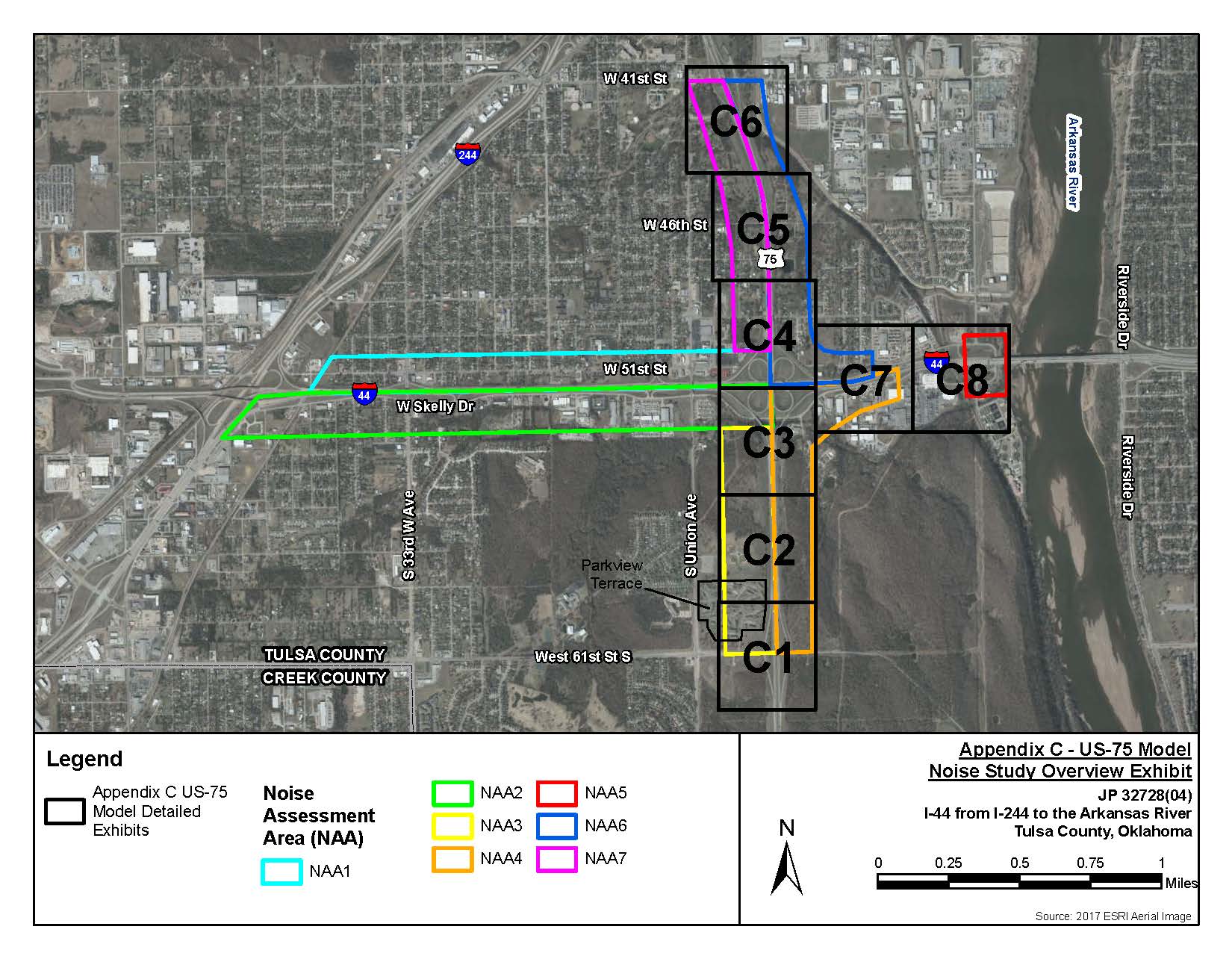Noise
What are the Noise Impacts?
The Oklahoma Department of Transportation (ODOT) completed Phase 1 of a two-phased noise study for the entire proposed I-44/US-75 interchange project. The noise study utilizes the FHWA Traffic Noise Model version 2.5 in accordance with FHWA 23 CFR 772 and complies with the ODOT Noise Policy dated July 13, 2011. Phase 2 of the noise study is ongoing.
PHASE 1 – Assessing Noise Impacts
The first phase was completed in 2019 that modeled the existing (2016) and future (design year 2045) noise levels based on roadway geometry, traffic volumes, terrain, and location of noise receptors such as homes, churches, and trails. The results of this modeling effort had identified where noise impacts will occur as result of the proposed improvements.
A total of 168 locations were analyzed representing 236 residential dwellings (single and multi-family), 2 places of worship, 2 parks, 3 trail systems, 1 library, 1 commercial establishment, 3 hotels, 1 nursing home, and 1 music recording studio.
Noise Impact Determination
As defined in the FHWA regulation and ODOT noise policy, noise impacts occur when:
-
Exterior noise levels are expected to reach 66 decibels (dB) for residential dwellings.
-
Interior noise levels are expected to reach 51 dB for auditoriums, day care centers, hospitals, libraries, medical facilities, places of worship, public or nonprofit institutional structures, radio studios, recording studios, schools, and television studios.
-
When there is an anticipated increase of future noise levels over existing noise levels of 15 dB or greater (interior and exterior).
As shown on the exhibits below, noise impacts are anticipated to occur at:
-
127 single-family residential dwellings
-
34 multi-family dwellings (Parkview Terrace)
-
1 neighborhood park at Parkview Terrace
-
Portions of 2 trail systems
Interior analyses were conducted for the Carbondale Church of Christ, Sherwood Manor Nursing Home, Tulsa City-County Library (Zarrow), Crossroads Tabernacle, and Drapp music recording studio. Only the Drapp music recording studio is impacted under future conditions with a level of 51.7 dB.
No locations (exterior or interior) will experience a substantial increase (15 dB) over the existing sound levels; the highest increase being 5.5 dB.
PHASE 2 – Consideration of Noise Abatement
The second phase of the study involves conducting a preliminary analysis of noise abatement based on the proposed design plans. Noise walls are considered the most appropriate form of noise abatement measure for the impacted receptors involved.
For a noise wall to be considered, it must meet ODOT Noise Policy criteria for “feasibility” and “reasonableness.”
“Feasibility” means it is possible to build the wall given site constraints such as drainage, safety, and utilities. A wall must also provide an acceptable reduction in noise levels to be considered feasible.
“Reasonableness” means the wall is fair and affordable according to ODOT Noise Policy. This includes consideration of how much noise will be reduced and at how many locations, cost of the wall, and the property owners and residents’ desire for the wall.
Noise Wall Analysis - Current Status
As of May 2021, eleven (11) noise walls are being evaluated and/or considered. Each of the noise walls are utilizing the original 2019 noise model and the current preliminary design plans. The length and heights of the wall segments are being designed in an effort to provide the maximum benefit while staying under the reasonableness cost per benefited receptor. Walls that meet the reasonableness cost criteria will be considered as part of the project moving forward. Input from the affected property owners and residents will be considered before any wall is finalized. Due to feasibility constraints, not all impacted receptors can be evaluated for mitigation.
NOISE MITIGATION COMMITMENTS
For those noise walls determined feasible and reasonable, the following is the general process in completing noise mitigation:
-
ODOT will contact all property owners and residents of the homes benefitted by the proposed noise walls. The primary method for notices will be by US mail.
-
ODOT will meet with the property owners and benefitted residents to present final details and to solicit the residents’ final views and opinions.
-
The decision on whether the wall is desired or not desired will be based on the preference provided by 51 percent or more of the benefitted property owners and residents that respond to the solicitation. Consideration of the wall will continue unless a simple majority of all distributed points are returned that indicates the balloted voters do not want the abatement measure.
-
The final determination on the noise wall will be shared with the property owners and residents by letter.
All other areas where noise walls were determined not feasible and/or reasonable will be shared to all affected property owners and residents by letter.
A Noise Mitigation Report for each project Work Package will be prepared summarizing the results of the barrier analyses, public involvement and the voting result. In addition, those impact areas that could not be mitigated will be addressed.

